Build a Strong Brand Identity in 2025 + Examples
Table of contents
The swoosh, two golden arches on a red background, or a bitten apple – no need to call the companies by name. You know, I mean Nike, McDonald’s, and Apple anyway. How is it possible? That’s how a strong brand identity works. Do you want your company to be equally successful? You are in the right place.
Brand identity is the visible elements of a brand, such as a logo, brand colors scheme, typography, and design style. These convey the brand’s values, personality, and promise to consumers. Brand identity is how a company wants to be perceived in the market.
Sharpening your brand’s image is key to grabbing new customers’ attention and being unforgettable.
When you refine your brand’s visual identity, you set yourself apart from the competition and attract more customers by staying true to who you are.
Ready to explore how to create a brand identity that truly shines?
Let’s dive in and discover the secrets to making your brand stand out.
What is brand identity?
It is the visual and conceptual representation of a brand.
It includes distinct elements, like logos, color schemes, and typography, as well as its unique voice, messaging, and values.
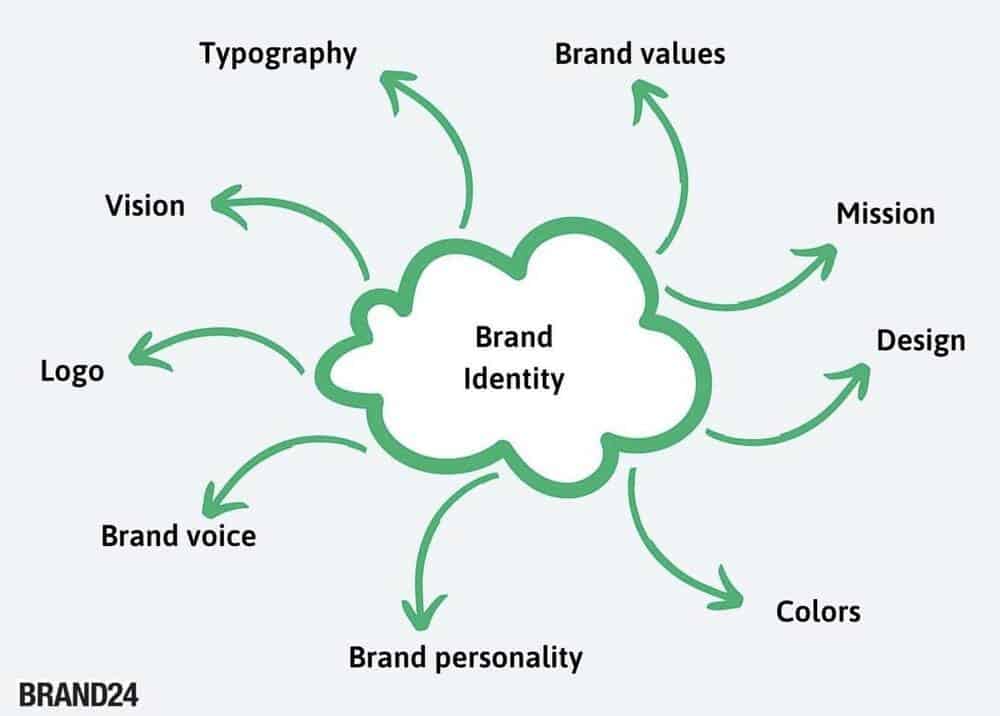
This set of characteristics forms a brand’s personality. It distinguishes the brand from competitors and creates a memorable impression on consumers.
A well-defined identity fosters brand recognition and builds trust and loyalty by conveying authenticity in every interaction.
It’s a crucial aspect of brand strategy influencing how the audience perceives a brand.
Why is brand identity important?
Brand identity is the heart and soul of your company.
A strong identity helps your potential customers recognize, relate to, and differentiate your brand from others in the market.
It provides a cohesive and memorable impression, fostering trust and making your brand more appealing and relatable.
Besides increasing brand equity, a strong identity supports the right brand positioning and building brand loyalty.
Monitor your brand identity results with Brand24!
How is brand identity different from brand image and branding?
Brand identity, brand image, and branding are interconnected aspects of a brand but carry distinct meanings.
Brand identity refers to the visual and sensory elements that define a brand, such as its logo, colors, and design, reflecting its essence.
Brand image is the perception and impression customers and the public hold about the brand based on their experiences, marketing messages, and interactions. It’s how the brand is perceived in the minds of the audience.
Branding is the strategic process of creating and managing the brand. It involves defining the brand’s purpose, positioning, and communication strategies.
In essence, brand identity is the tangible representation, brand image is the perceived impression, and branding is the ongoing strategic process that shapes both.
How to build a strong brand identity in 10 steps?
Brand identity is the key to developing a successful brand.
Learn the 10 fundamental steps to creating a brand with an excellent identity that will boost your business.
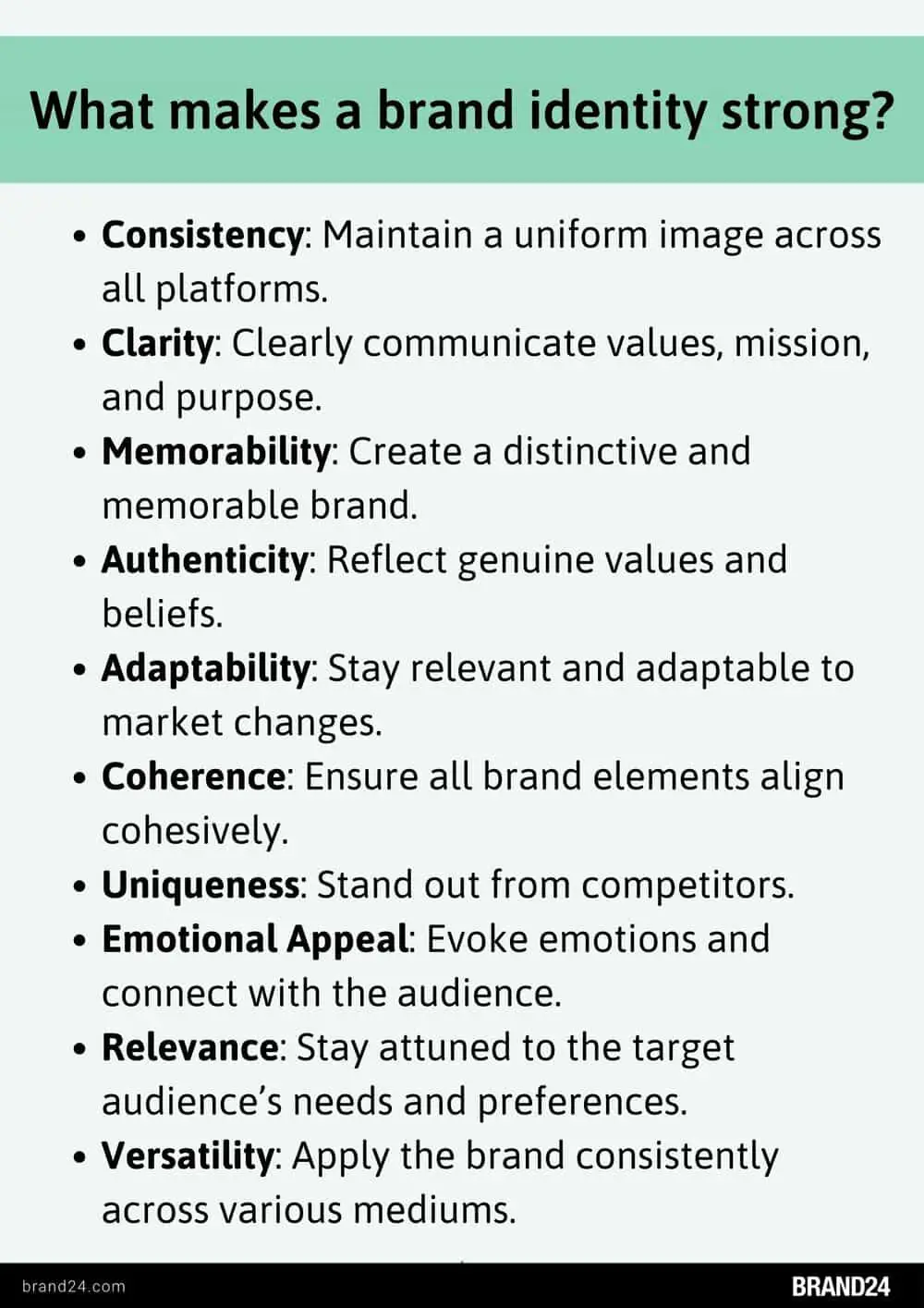
01 Conduct thorough market research
Market research plays a crucial role in shaping and refining the identity of a business.
Through extensive market reckoning, you gain a deep understanding of your brand positioning, competitors, and industry trends.
There are several types of research you can conduct. Here are the main ones:
- Marketing research
- Competitor research
- Product research
- Consumer research
- SWOT analysis – Assess your company’s strengths, weaknesses, opportunities, and threats.
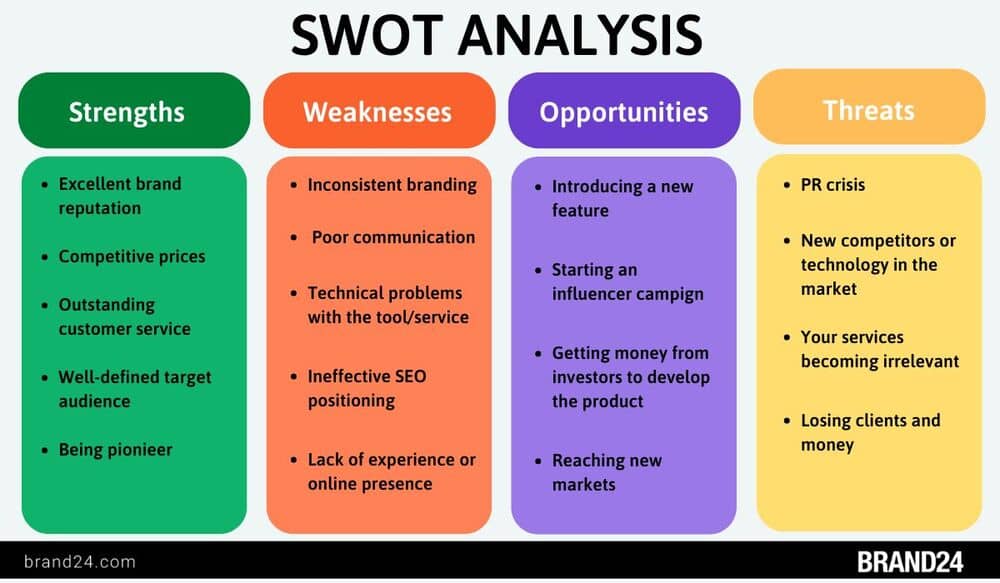
Using these techniques helps identify unique selling points, brand values, and digital marketing strategies to set your brand apart.
It provides a foundation for crafting a brand image that aligns with the target market’s needs and desires.
Ultimately, it contributes to a more effective and successful brand identity.
Brand24 is one of the best market research tools. It collects online data about your brand, company, niche, audience, competitors and turns them into actionable insights.
Create a strong brand identity! Research the market with Brand24.
02 Analyze your target audience
Market research is an extensive and insightful step but not an exhaustive one. In addition to knowing your target market, you need to learn a thing or two about your audience.
This will help you better understand your customers and create a personal connection with them.
Leverage social listening tools to ensure no critical mention will go unnoticed.
You can rely on Brand24’s social listening capabilities whether you are a huge corporation or a small business.

Meet your target audience through Brand24.
03 Define your brand personality
This step involves crafting a distinct character for your company. You must create a brand identity that resonates with your audience and fosters an emotional connection.
Start by aligning your mission, vision, and brand values. Ensure consistency across all elements.
Your brand story should narrate your business’s journey, values, and purpose, creating a narrative that customers can relate to.
This process provides a solid foundation, helping to build authenticity and trust.
By carefully shaping your brand personality, you lay the groundwork for a compelling and memorable brand identity design that sets your business apart in consumers’ minds.
Pro tip: Leverage social listening insights from the previous step to imagine your buyer personas and perfect customers. Are they young or mature audience? Are they located all over the world or in a specific region? Adjust your presentation accordingly.
05 Develop a consistent brand voice
This and the next step are all about creating a strong brand identity from scratch.
I cover all the brand elements, so you get a complete list of what needs to be prepared for a well-defined brand identity.
You can involve a brand strategist to help you with this task or do it on your own, equipped with actionable insights from Brand24.
Ready to grab the know-how?
Voice is a pivotal element of brand identity. It is all about how your brand interacts with its audience.
Your brand’s voice reflects its personality, and the tone sets the mood for communication.
Consistency across various platforms and interactions fosters brand recognition and trust.
A well-defined voice and tone resonate with your target audience, creating a memorable brand experience.
When you establish a default communication style, it’s good to write down the brand guidelines. This way, everybody in the company can consult them.
This ensures cohesion between the brand guidelines, online and offline communication, marketing materials, and any other type of content created.
The worst thing you could do is serve your audience mixed messages. That could confuse them and lower the credibility of your brand.
Brand24 offers an Emoji Analysis that reveals your audience’s favorite symbols. This feature allows you to adjust not only the tone of conversation but also the emojis you use.
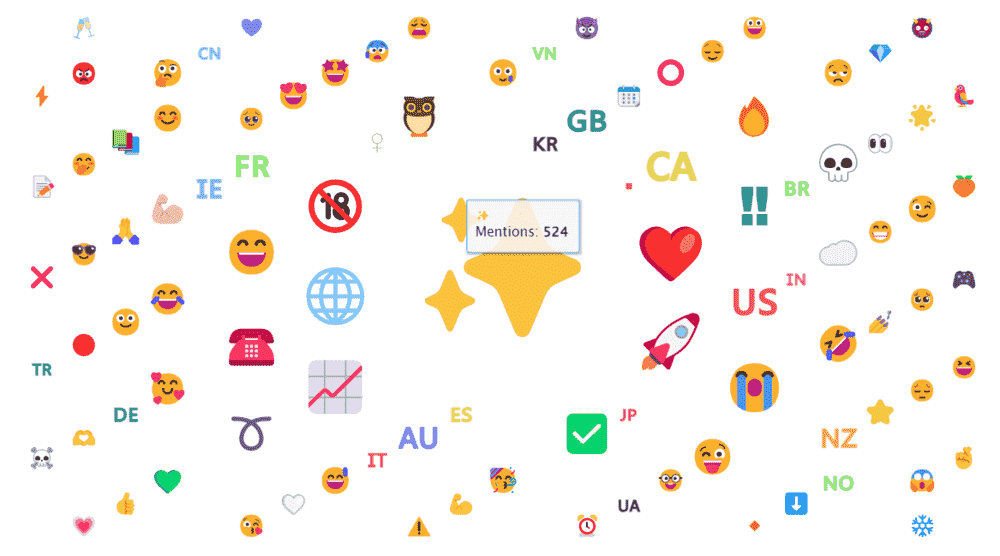
Analyze your target audience with Brand24.
06 Establish a visual identity
Here are the seven key elements of the visual identity of your brand.
The alignment between all of them ensures effective visual branding that makes a powerful brand.
To ensure this project’s success, you may need help from a graphic designer. Alternatively, you can do it on your own using a dedicated tool like Canva or Looka.
Now, let’s move on to the seven key elements of the visual identity of your brand.
Brand colors
Colors convey emotions, values, and personality, making them a powerful element of visual brand communication.
Ever heard of the color theory?
It’s your best friend when creating a brand identity.
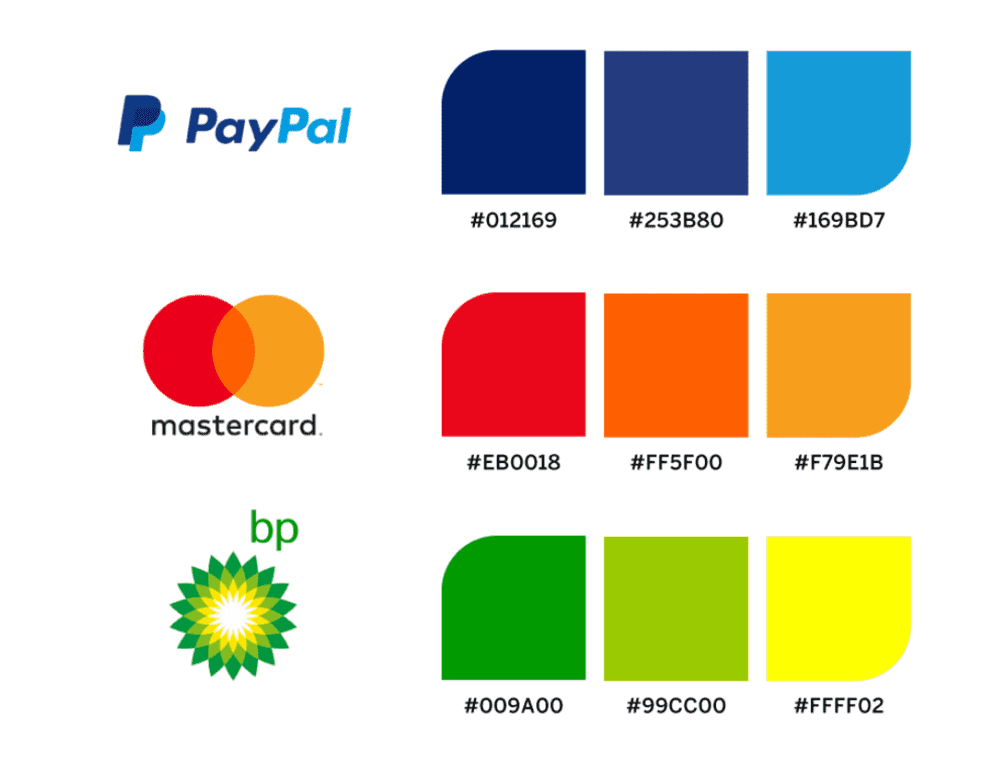
The chosen color palette should align with your brand’s essence, target audience, and industry standards.
For example, warm tones like red or orange evoke energy and passion, while cool blues represent trust and professionalism.
Consistency in color usage across various platforms fosters brand equity and recognition.
It’s not just about aesthetics; it’s about creating a visual language that resonates with the audience and distinguishes the brand in a crowded market.
You must consider primary and secondary colors when establishing your brand’s color palette. The former are the main colors dominating your marketing materials and website. The latter are the colors that appear less but complement your primary colors.
Company logo
This visual mark serves as the face of the brand’s identity, encapsulating its values and personality.
The logo design should be distinctive, memorable, and scalable, ensuring adaptability across various mediums.
Whether a minimalist emblem or an intricate design, the logo becomes the emblematic identifier, triggering instant brand recall.
The color, font, and imagery within the logo contribute to the overall narrative a brand seeks to convey.
It’s not merely a graphic; it’s a symbol that encapsulates the brand’s essence and communicates it to the world.
The Nike swoosh, McDonald’s golden arches, or Apple’s bitten apple exemplify the enduring impact a well-designed logo can have on brand perception and recognition.
You can try tools like Looka or Canvas to experiment with your logo.
Brand fonts and shapes
Fonts and shapes play a key role in shaping the visual identity of a brand. The choice of fonts communicates a brand’s personality and sets the tone for its messaging.
Whether a sleek and modern sans-serif font or a classic and elegant serif, each typeface carries a distinct vibe.
Shapes, on the other hand, contribute to the overall design language. Geometric shapes may evoke a sense of precision and order, while organic ones can bring warmth and friendliness.
Every curve, line, and letter contributes to the brand’s story.
Mascot or representative
Mascots and brand representatives serve as charismatic ambassadors, breathing life into a brand’s visual identity.
These iconic figures embody the brand’s personality, creating a memorable and relatable connection with the audience.
Whether it’s a mascot’s friendly face or a trusted brand persona, these characters become consumers’ visual and emotional anchors. They raise brand awareness and nurture genuine connections with customers.
The use of mascots can evoke a sense of playfulness or nostalgia, while human representatives bring authenticity and trust.
Think of the Duracell Rabbit, the Geico Gecko, the Michelin Man, or the affable Flo from Progressive. These characters transcend their commercial roles, becoming integral to the brand narrative.
They bring in added value by spreading trust and positivity.

Imagery and symbols
In brand identity design, symbols and imagery are strategically used beyond a company’s logo. They encompass a variety of other visual elements and details woven into its broader narrative.
The consistent integration of these symbols and imagery across various brand expressions contributes to a holistic and engaging brand identity. It offers a rich visual tapestry that resonates with the target audience.
This is one of the final steps that eventually binds your brand design together and makes you unique.
Product packaging
Product packaging is a tangible representation of a brand’s essence.
Every visual aspect of packaging plays a crucial role, from the color palette and right typography to size, shape, and the inclusion of logos, imagery, or patterns.
The packaging is not just a protective shell for the brand’s products but a canvas for its personality and expression.
Take Apple’s minimalist yet sleek packaging, for example. It mirrors the design philosophy of its devices.
It’s an artful fusion of aesthetics and functionality, ensuring that the first touchpoint with a product resonates with the consumer’s brand perception.
Crafting a compelling brand identity through packaging involves considering how each visual element aligns with the brand narrative.
By curating the above seven elements, you ensure that your business’s identity will be successful in all areas of its presence and easily recognized by its customers.
Monitor your brand identity reception with Brand24.
07 Create branded templates
Having decided on all the visuals for your brand, collect all this knowledge in one place.
This way, you ensure that everybody in your company contributes to creating a cohesive brand identity.
Templates encapsulate the brand’s essence through standardized designs, including fonts, color palette, and layout structures. They will be handy for the types of content that you create frequently.
Branded templates ensure a cohesive brand design and streamlined creation process for social media posts, presentations, or marketing campaigns.
08 Create a brand book
That’s an important step to maintain consistency. The brand book is the brand style guide everybody in the company should have at hand.
A visual brand book is instrumental when you need to create something from scratch and cannot use templates. It will guide you through all the available colors, fonts, and designs your company accepts.
Collecting all the brand guidelines in one place and keeping them updated is a critical step toward a great brand identity.
Creating a brand identity made easy.
09 Be consistent across all channels
With templates and a brand book at hand, this shouldn’t be a big deal. You simply need to stick to the initial decisions and guidelines.
10 Monitor your audience’s reactions
Brands invent their images and identities to foster customer loyalty.
But the work doesn’t end here.
You must check if the proposed brand image got your audience’s approval. Do this by measuring the emotions and buzz around your brand.
Not all brand identity design changes have been successful in history. Many brands, including Gap, Tropicana, and MasterCard, learned their lessons the hard way.
They introduced new designs but had to return to the previous, well-known, and liked brand identities and logos.
To prevent a PR crisis caused by a rebranding attempt, leverage the power of Brand24.
The tool monitors your mentions and online metrics in real time, allowing you to respond promptly to any emerging issues and concerns.
The most useful features for brand identity monitoring are:
Sentiment analysis
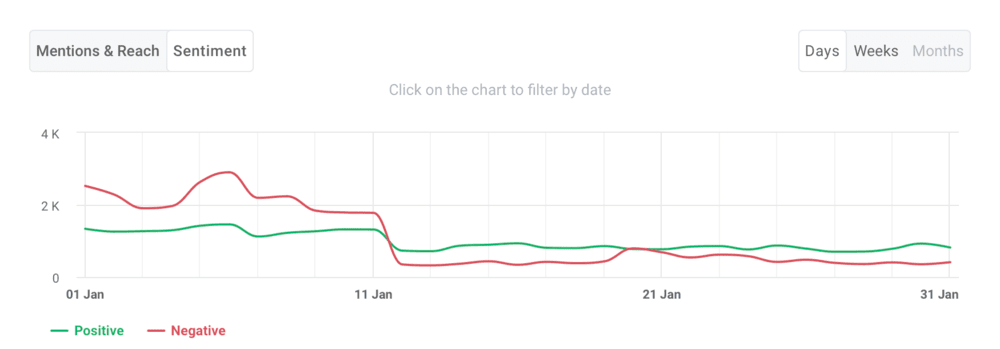
This feature is useful for assessing the general sentiment around your brand. It provides immediate insights about your reception online.
Anomaly Detector
This is one of our outstanding features that you won’t find in other media monitoring tools.
Our Anomaly Detector notifies you about the sudden buzz around your brand. But not only that. It also detects the reason behind it.
See those mysterious exclamation marks on your Mentions & Reach chart?

Don’t hesitate to click on them!

AI-powered emotion analysis
Sentiment analysis is usually limited to positive, negative, and neutral.
Not at Brand24!
Thanks to AI, we can detect nuanced emotions like admiration, fear, anger, joy, disgust, and more!
Creating a strong brand identity made easy.
Period comparison
This feature makes it easy to measure the effectiveness of your actions, including marketing campaigns and brand identity adjustments.
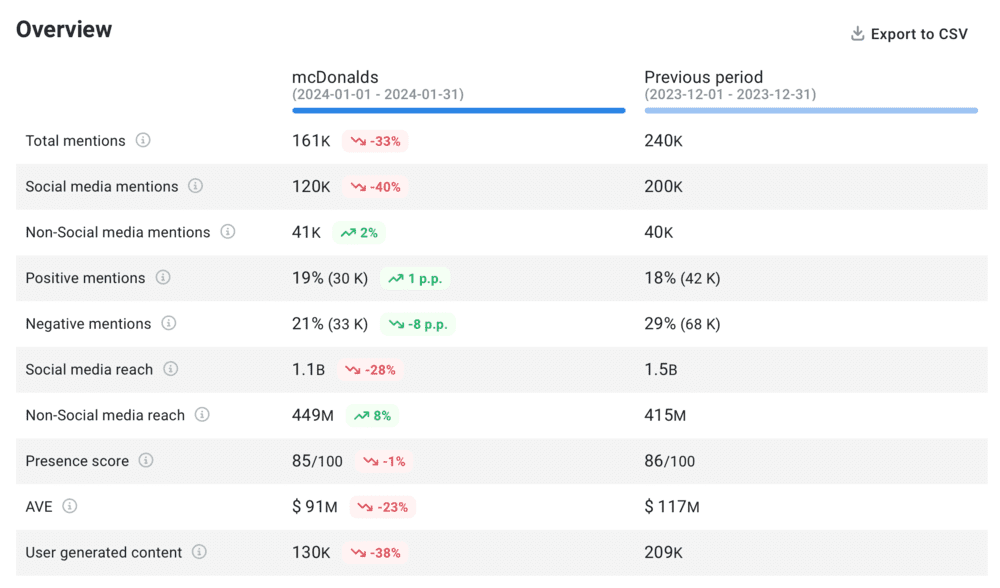
Mentions Tab
That’s where you can find firsthand insights from your audience and gain a deeper understanding of how they perceive you.

Try the best brand management tool!
What to avoid when building brand identity?
01 Don’t copy your competitors.
That would be the worst idea ever. You need a distinct offer to stand out in the market.
02 Don’t assume you know your audience’s expectations. Ask them through surveys or leverage media monitoring.
Learn more on how to collect customer feedback here.
03 Don’t play too safe. Be real, be different, be yourself.
Think about Ryanair, which mocks the fact that it is a low-cost airline. Thanks to its brutally honest jokes and memes, it has improved its reception and brand awareness.

04 Don’t confuse your audience. Don’t send mixed messages.
It’s not only about your brand tone of voice. It’s also about its values.
Be wise when supporting a cause. Your audience will want you to prove your dedication.
A good example is Nike, which uses single-leg mannequins but refuses to sell single shoes. This issue escalated to a significant controversy this year when a Paralympian brought this topic up to Nike.

Long story short, be consequent when you support a certain cause.
Nowadays, people hate hypocrisy!
Authentic identity is the best strategy.
Strong brand identity design examples
Many brands did a fantastic job establishing their brand personality and brand identity design. Let’s study their cases and discover the secrets of some of the best brand identities.
Apple
Apple stands as a paragon of simplicity, innovation, and aesthetic prowess. The iconic half-bitten apple logo is globally recognized, symbolizing a blend of creativity and user-friendly technology.
Apple’s minimalist design philosophy extends to every facet, from product packaging to retail stores, creating a seamless and immersive experience.
Its distinctive white earbuds, sleek devices, and uncluttered store layout are all integral components of its brand identity.

The consistent use of a clean, sans-serif font, paired with a muted color palette, reinforces a sense of sophistication and modernity.
Beyond the visual, Apple’s brand identity is woven into its communication style — concise, aspirational, and often challenging the status quo.
This cohesion across design, products, and messaging has forged a brand identity that transcends technology, embodying a lifestyle and a design philosophy that millions aspire to be a part of.

Build a brand identity with Brand24 insights!
Coca Cola
Coca Cola’s brand identity is the epitome of timeless tradition and global appeal.
The brand’s signature red color and iconic scripted font create an unmistakable visual identity that has endured for over a century.
The curvy contour bottle design is not only a functional choice but has become an integral part of the company’s recognition.

Coca Cola’s imagery often revolves around moments of joy, celebration, and togetherness, emphasizing the emotional connection with the brand.
The brand consistently infuses its messaging with positivity, promoting happiness and refreshment.
Coca-Cola’s identity is not just about a beverage; it’s about fostering shared moments, creating a sense of nostalgia, and maintaining an enduring presence in the hearts and minds of consumers worldwide.
Nike
Nike, a global powerhouse in athletic wear, boasts a successful brand identity that resonates with the spirit of athleticism, empowerment, and innovation.
The iconic Swoosh logo, simple yet dynamic, captures the essence of motion and speed.
The “Just Do It” tagline has become synonymous with determination and achievement, transcending the realm of sports into everyday life.
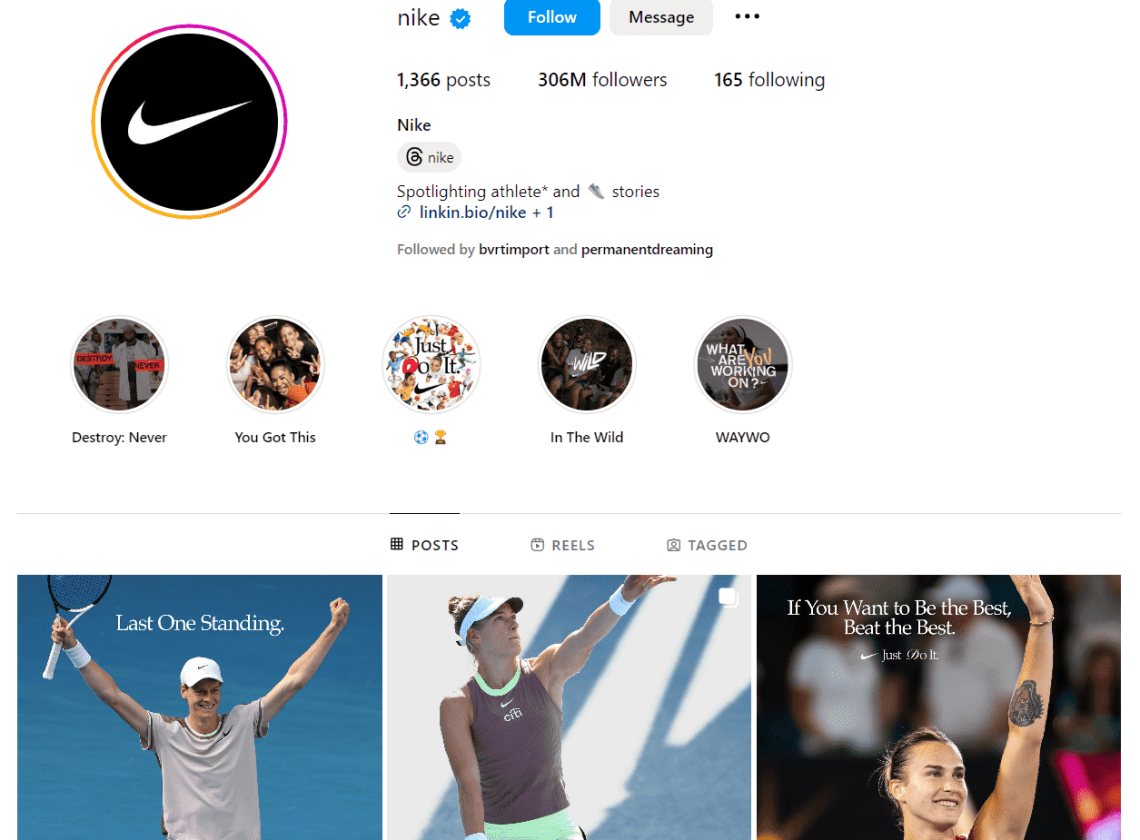
Nike’s influencer marketing often relies on high-profile athletes, reinforcing the brand’s commitment to excellence.
Nike has positioned itself not just as a sportswear brand but as a symbol of motivation, pushing boundaries, and pursuing one’s goals. This identity inspires and connects with consumers globally.
However, a brand identity master like Nike can make mistakes, as shown above.
Duolingo
No matter if you use the app, when I say Duolingo, you immediately think about a green owl. Duolingo succeeded in creating a compelling identity with its unique mascot.

The app’s intuitive user interface features vibrant colors and engaging graphics that create an inviting learning environment. Duolingo’s gamified approach, incorporating achievements and rewards, adds an element of fun to the language-learning journey.
The brand consistently uses these visuals across its marketing materials, creating a cohesive and recognizable presence.
Combining a distinctive mascot, user-friendly design, and a cheerful brand tone of voice has contributed to Duolingo’s success in establishing a unique and memorable brand identity.

What’s also significant about Duolingo’s brand image is its playful, humorous style.
On the canvas of the memes created by Duolingo users, the company decided to change its brand voice and build itself up with the mascot of the evil owl.

This brand strategy turned out to be a bull’s eye!
Duolingo created a unique, recognizable brand identity visible on its social media. The company’s accounts attract thousands of followers and fans fascinated by the playful image of the evil owl.
On the other hand, this example shows that your company’s brand identity should be aligned with your target audience.
Duolingo made a brave decision and put all its eggs in one basket.
Luckily for the company, the reception of its new brand identity was fantastic and appealed to its young users.
Remember that this kind of decision needs to be well-thought-out and aligned with your target audience.
Monitor the effects of your rebranding with Brand24.
Is it possible to change brand identity?
Yes, that’s what rebranding is all about. You can change all the key elements of your brand image. This needs to be a well-thought-out decision.
If you don’t feel safe and sure about it, consider consulting with brand strategists.
Creating a new brand identity is a big challenge, especially if you already have a profitable and recognizable brand.
Many companies have tried to change their brand image by updating design assets like logos, fonts, or other brand elements. Not all of them succeeded.
That’s why the decision should be planned in detail.
Plus, your audience must be prepared for the upcoming changes. Remember that your brand’s new identity must align with your brand story and brand assets so as not to confuse your customers.
Conclusion
Understanding brand identity and its importance lays the groundwork for building a solid and enduring business presence.
The 10 steps outlined here provide a comprehensive guide to shaping a business identity that resonates with your audience, incorporating key elements such as mission, vision, values, brand story, and personality.
By exploring examples of strong brand designs, businesses can draw inspiration for their unique visual and conceptual representation.
Now that you are armed with the knowledge and tools to make your brand unique, the invitation is clear: start building your brand’s identity today.
Whether you are a startup or an established business, a strong company identity is not just a logo; it’s the essence of your business that leaves a lasting impression on customers and sets the stage for long-term success.
Turn your average brand image into a great brand identity with Brand24.
Key takeaways:
- Brand identity is the collection of visual and tangible elements that represent a brand, including its logo, colors, typography, and overall design. These elements reflect the brand’s values and personality to create a consistent and recognizable image.
- Marketing research is an important part of strategic brand identity planning and design.
- Create a good brand book to ensure a cohesive brand identity.
- Leverage social listening and media monitoring with Brand24 and become better than other brands in your niche!
The best brand strategy and identity insights with Brand24.



